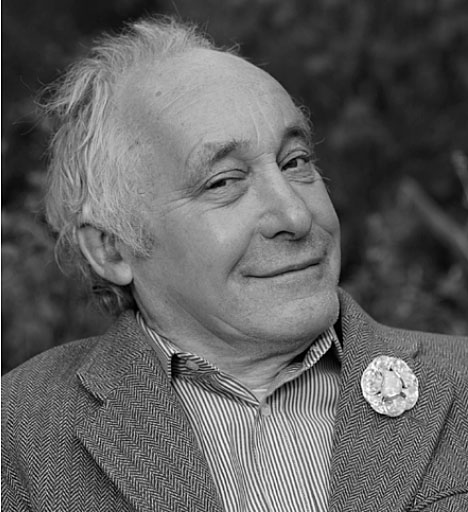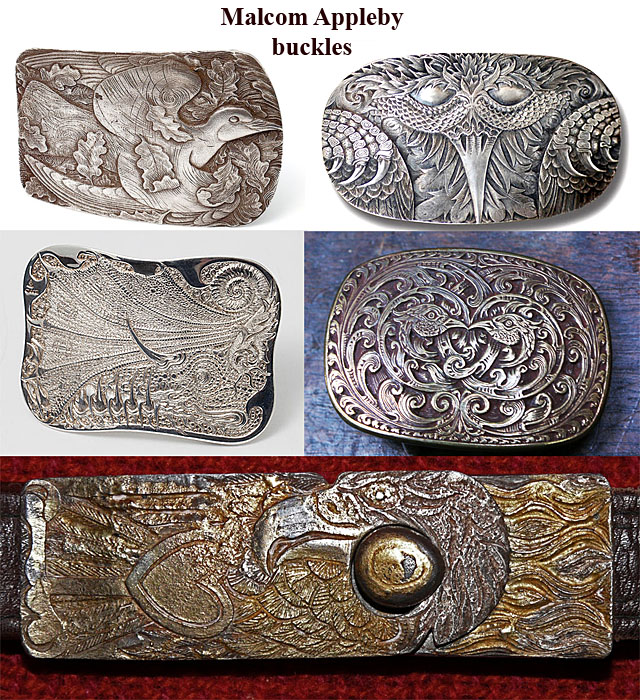quote:
Malcolm Appleby, maker
4 - 28 July 2012 
The Scottish Gallery is delighted to host this solo exhibition of Malcolm Appleby, known primarily as an engraver and considered to be one of the most original and highly skilled craftsmen working in Britain today. His prolific output ranges from sculptural table pieces to small silver buttons. Constant experimentation adds an element of the adventurer to his work, and he moves freely between exquisitely detailed engraving to bold cutting and texturing of metal. Whatever the scale, his individuality and vitality of gesture mark each piece. Malcolm Appleby’s outstanding career spans 45 years, promoting engraving through his own work and providing opportunities for young engravers and silversmiths. Aberdeen Art Gallery hosted Malcolm Appleby Designer and Engraver in 1998 and The Goldsmiths’ Company, London honoured his career with a retrospective exhibition called Precious Statements in 2006. Maker is a celebration of this remarkable talent and the long association the Gallery has enjoyed with Malcolm Appleby over the last three decades.
“I’m passionate about the amount of energy and power that springs from the
ancient craft of engraving.”
A BRIEF HISTORY
1946 Born, Beckenham Kent
Trained at Beckenham School of Art Ravensbourne College of Art & Design Central School of Arts & Crafts Sir John Cass School of Art Royal College of Art
He settled in Scotland in 1969 and opened his first workshop in Crathes, Aberdeenshire before setting up his current workshop in Perthshire in 1996.
Medals
Malcolm Appleby made his first medal in 1968 at the Royal College of Art. Cut into mild steel, the Cockatrice, a beautiful but malign fantastical creature with the head and claws of a cockerel and the body of a serpent, was struck in lead. The medal’s restrained form has provided scope for Appleby’s imagination over the years. The exhibition Medals Today in 1973 at Goldsmiths’ Hall marked a deliberate move by the Worshipful Company of Goldsmiths to promote contemporary medals. Appleby exhibited eight medals including two struck especially for the exhibition: Birds of Destiny (a crow and stork conjoined) and Human Butterfly (a face within a butterfly’s body). Other medals included commissions for the Mammals Society and the World Wildlife Fund, Owl (engraved in high relief), and the small medals that eventually become silver buttons, pendants and cufflinks appear from this period, marvelous miniatures, depicting birds and beasts, insects, leaves and flowers, and other themes quite in keeping with the spirit of the medal. Private commissions have commemorated family weddings or births, family crests and other personal associations.
In 1983 Appleby struck a medal to commemorate Dick Whittington, the first Crathes Pantomime; a medal for each subsequent pantomime featured one of the characters and a catch-phrase from rehearsals. The foundation of the British Art Medal Society provided further impetus for medal making. Appleby has produced three medals for BAMS: The Horrors of War (1983) cast from a group of melting plastic soldiers, inspired by Goya’s etchings; Fall Out (1986) a struck medal, commenting on nuclear and acid rain pollution; and Parma (1991) cast from an engraved original commemorating the 60th anniversary of the purchase and sailing of the Finnish-British vessel whose shareholders included Appleby’s father and grandfather. The National Trust for Scotland commissioned a medal to commemorate their Diamond Jubilee in 1991 and in 1998 the Royal Museum of Scotland commissioned a medal for the opening of the new Museum of Scotland. In 2000, Appleby designed and produced a new Royal Medal to be awarded annually through the Royal Society of Edinburgh in recognition of outstanding scholarship, encompassing all areas of intellectual endeavour. Three gold medals are presented annually. Between 2003 and 2008 Appleby produced a gold medal for the Gannochy Trust Awards, presented by the Royal Society of Edinburgh.
THE TRAFALGAR MEDAL
In 2005 Appleby created The Trafalgar Medal, in collaboration with naval historian Sim Comfort, to commemorate the bi-centenary of the Battle of Trafalgar (21st October 1805). The obverse of the medal depicts Victory as she raised the famous ‘England Expects’ signal at 12 noon as she nears a wall of fire from the combined fleet of France and Spain. The reverse depicts the battle at 1.45pm – Nelson has fallen and Victory and Temeraire are ‘locked in mortal combat’ with Le Redoutable. The quality of the Trafalgar Medal was recognize in the Goldsmiths’ Company Craftsmanship & Design Awards 2006: Malcolm won the gold award for engraving the medal and silver award for the modelling. Most recently, Malcolm produced the medal for FIDEM XXXII Art Medal Congress, Glasgow 2012 (July). He continually uses die-sinking techniques for buttons, jewellery and hollow ware (silver).
Gun Engraving
Gun engraving and design have always formed a significant part of the Appleby oeuvre. John Wilkes, who died in 2010, encouraged him and he studied part-time as an engraving apprentice at art school. After his move to Scotland, Appleby continued to work with Wilkes and other gunmakers.
When Appleby bought a Wilkes action ‘in the white’ for himself (1981) the opportunity to create something new in gun engraving design presented itself. Appleby’s simple but radical idea was to make the gun into a ‘totem’ object representing a bird or beast. The guns of this style include the Woodcock, the Crocodile, the Pike, the Dragon, and most recently, the Phoenix.
In 1986, The Royal Armouries commissioned Appleby to design and engrave the first modern masterpiece for their collection in the Tower of London - the Raven Gun. From 1991 Malcolm produced designs for guns for Holland & Holland that were engraved in their own workshops. Several private commissions have also given Malcolm the imaginative scope in this field, in particular guns featuring African Birds and Beasts.
Today he has several gun commissions in the pipeline that will allow him to explore the creative possibilities of this medium. While the gun designs have a gravitas that befit their function, the occasional Appleby sense of humour manages to creep in … a gold inlaid mole peers out from under the safety catch, midges tumble down the breach of a Scottish beasties gun and there are appropriately sized ticks on the dragon and phoenix guns!
Banchory Bangle
Each year Malcolm engraves a gold bangle that is raffled for the charity Children First drawn in Aberdeen during November. Typically featuring Scottish flora and fauna, a new Banchory Bangle is an eagerly awaited event with silver versions of the bangle available to purchase. The 2006 Banchory Bangle in 18ct gold, with 13 primrose flower heads set with 13 tiny white diamonds – ‘the Spinkie’ – raised an exceptional £12,500 for the charity. The 2007 bangle featured Peacocks and won two awards in the 2008 Craftsmanship and Design Awards – Gold Award, Engravers Senior and Silver Award, Prototype Production Jewellery. For 2008, to mark 40 years in business, Malcolm created a stunning pierced and engraved bangle, representing the Scottish Rose, set with 40 Scottish garnets (known as Elie rubies). The 2009 bangle featured zoomorphic-style interweaving cats and for the 2010 bangle, Malcolm created a bangle that features tiny butterflies, each one engraved with different patterns. The 2011 Oak and Acorn bangle featured leafy engraving while the 2012 bangle is poetically called ‘Flowers of the Forest’ and is a new style of three dimensional pierced out flowers with deer and doves in the background. Silver versions of the new bangle are available in November, along with the silver versions of the bangles created during the last fifteen years.
some Highlights from the last five years
- Drawings and designs for Dragonfly/Damselfly gun.
- Drawings and test engraving design work for Kalahari flora and fauna guns (the test plate won Gold and Special Council Award (Engravers) and Silver award (Modellers) at the Goldsmiths’ Crafts and Design Council Awards 2012)
- Phoenix Gun, Private Commission completed 2012; Special Council Award, Golsmiths’ Craft Council Awards 2011
- The sale of an important 1980s Appleby gun (The Crocodile Gun) at Gavin Gardiner/Gleneagles Sale, Perthshire in 2009 “a magnificent and truly Scottish gun”, sparked a return to gun engraving.
- Loving Cups, set of three standing cups designed and engraved for George Heriot’s School to mark their 50th Anniversary in 2009
- Annual gold Royal Medals for the Royal Society of Edinburgh
- ‘Made in Scotland’ at The Fleming Collection, London April-June 2012
- British Silver Week’s ‘A Festival of Silver 2012’ venues round the country (June/July)
- ‘Craft in Dialogue’ exhibition of former winners of the Inches Carr Trust craft bursaries, Dovecot Gallery, Edinburgh, 2011
- Participated in 30 Years of Bishopsland Trust’s work at the Whitely Silver Galleries of the V&A and Dovecot, Edinbugh
- Regular awards for engraving at the Goldsmiths’ Craft Council Competition; awards for ‘apprentice’ pieces by Callum Strong and Aileen Tan, both engraving students of Malcolm’s
- Appleby’s ‘Prince of Wales Cup’ engraved in 1970 with feathers, lion, unicorn and dragon imagery, when he was only 23 years old, sold at Bonhams’ ‘Distinguished Designs’ auction in 2011 for £75,000, setting a new record for any post-war silver or gold item
selected Public collections and significant commissions include:
Condiment set for 10 Downing Street, London (The Silver Trust)
Seal for the Board of Trustees of the Victoria & Albert Museum, London
Standing Cup and Cover for the National Museums Scotland, Edinburgh
Raven Gun for Royal Armouries, Tower of London
An engraved silver teapot and beaded bowl for Perth Museum and Art Gallery
Table centrepiece for Bute House, the First Minister of Scotland’s residence
Medal to celebrate 200 years of the Battle of Trafalgar
The Victoria & Albert Museum, London
The Goldsmiths’ Company, London
British Museum, London
Royal Armouries, Tower of London
Ashmolean Museum of Art & Archaeology, Oxford
Aberdeen Art Gallery & Museums
The Fitzwilliam Museum, Cambridge
National Museums Scotland, Edinburgh
Perth Museum and Art Gallery
The Hunterian, University of Glasgow


 SMP Silver Salon Forums
SMP Silver Salon Forums

 Silver Jewelry
Silver Jewelry

 Malcom Appleby buckles
Malcom Appleby buckles








